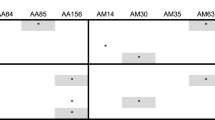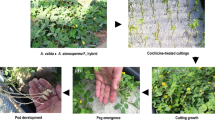Abstract
Polyploid breeding offers the possibility of increased variability in the search for improved growth, site adaptation and disease resistance in tropical acacias. A key focus of breeding in Vietnam has been the production and testing of vigorous triploid clones which are expected to have the added advantage of being sterile. Triploids obtained by manual crosses between diploid and tetraploid trees or by bulk screening of seedlings derived from open-pollinated seedlots were verified using flow cytometry. Thirteen clones are under field testing for growth rate, tree form and fertility. Six of these are now reproductively mature and flowered as prolifically as diploids. However no pollen germinated, either on agar or on their own stigmas under controlled pollination. Only one clone (X01—F1 hybrid of tetraploid A. mangium and diploid A. auriculiformis) produced open pollinated pods on 0.05% of hermaphrodite flowers and these contained an average of 1.3 filled seeds per pod, about one-fifth the number observed in diploids. Less than 25% of germinated progeny from this triploid clone survived at 3 months after sowing and survivors were severely stunted with arrested growth. Ploidy and genotype analysis revealed them to be predominantly aneuploids, ranging from hyperdiploid to hypotetraploid with 95% being selfs. We are confident that we can select triploid clones which will be effectively infertile if deployed in plantations and may be of particular value in situations where the normal prolific natural regeneration of tropical acacias is highly undesirable.



Similar content being viewed by others
References
Barringer BC, Geber MA (2008) Mating system and ploidy influence levels of inbreeding depression in Clarkia (Onagraceae). Evolution 62(5):1040–1051
Blakesley D, Allen A, Pellny TK, Roberts AV (2002) Natural and induced polyploidy in Acacia dealbata Link. and Acacia mangium Willd. Ann Bot 90:391–398
Brewbaker JL (2013) ‘KX4-Hawaii’, seedless interspecific hybrid Leucaena. HortScience 48(3):390–391
Butcher PA, Moran GF (2000) Genetic linkage mapping in Acacia mangium. 2. Development of an integrated map from two outbred pedigrees using RFLP and microsatellite loci. Theor Appl Genet 101(4):594–605
Chen C-C, Grant W (1968) Morphological and cytological identification of the primary trisomics of Lotus pedunculatus (Leguminosae). Can J Genet Cytol 10(1):161–179
Cheng S, Huang Z, Suo Y, Wang J, Kang X (2015) Gene expression differences associated with growth vigor in Populus full-sib allotriploid progeny following manipulated first division restitution of the diploid maternal parent. Euphytica 203(3):683–700
EEC (1978) Laying down detailed rules for the certification of hops. No 890/78 of 28 April 1978
Glick L, Sabath N, Ashman T-L, Goldberg E, Mayrose I (2016) Polyploidy and sexual system in angiosperms: is there an association? Am J Bot 103(7):1223–1235
Griffin A, Midgley S, Bush D, Cunningham P, Rinaudo A (2011) Global uses of Australian acacias–recent trends and future prospects. Divers Distrib 17(5):837–847
Griffin AR, Vuong TD, Vaillancourt RE, Harbard JL, Harwood CE, Nghiem CQ, Thinh HH (2012) The breeding systems of diploid and neoautotetraploid clones of Acacia mangium Willd. in a synthetic sympatric population in Vietnam. Sex Plant Reprod 25(4):257–265
Griffin A, Twayi H, Braunstein R, Downes GM, Son DH, Harwood CE (2014) A comparison of fibre and pulp properties of diploid and tetraploid Acacia mangium grown in Vietnam. APPITA 67:43–49
Griffin AR, Nghiem Quynh C, Harbard JL, Do Huu S, Harwood CE, Price A, Tran Duc V, Koutoulis A, Ha Huy T (2015) Breeding polyploid varieties of tropical acacias: progress and prospects. South For 77(1):41–50
Harbard JL, Nghiem QC (2014) Production of open pollinated triploid Acacia in a polyploid hybridising orchard in Vietnam and early data on triploid sterility. In: IUFRO Acacia 2014 “Sustaining the Future of Acacia Plantation Forestry”, Hue, Vietnam
Harbard JL, Griffin AR, Foster S, Brooker C, Kha LD, Koutoulis A (2012) Production of colchicine-induced autotetraploids as a basis for sterility breeding in Acacia mangium Willd. Forestry 85(3):427–436
Harwood CE, Ha Huy T, Tran Ho Q, Butcher PA, Williams ER (2004) The effect of inbreeding on early growth of Acacia mangium in Vietnam. Silvae Genet 53:65–69
Harwood CE, Hardiyanto EB, Yong WC (2015) Genetic improvement of tropical acacias: achievements and challenges. South For 77(1):11–18
Haunold A (1970) Fertility studies and cytological analysis of the progeny of a triploid × diploid cross in hop, Humulus lupulus L. Can J Genet Cytol 12(3):582–588
Husband BC (2004) The role of triploid hybrids in the evolutionary dynamics of mixed-ploidy populations. Biol J Lin Soc 82(4):537–546
Kha LD (ed) (2001) Studies in the use of natural hybrids between A. mangium and A. auriculiformis in Vietnam. Agricultural Publishing House, Hanoi
Kha LD, Griffin R, Thinh HH, Harbard J, Son L, Hoa DT, Chi NQ (2009) Research on ploidy identification and characterization of Acacia mangium tetraploids in comparison with diploid clones in Vietnam. Sci Technol J Minist Agric Rural Dev 9:114–120
Kha LD, Harwood CE, Nguyen Duc K, Baltunis BS, Nguyen Dinh H, Ha Huy T (2012) Growth and wood basic density of acacia hybrid clones at three locations in Vietnam. New For 43(1):13–29
Köhler C, Mittelsten Scheid O, Erilova A (2010) The impact of the triploid block on the origin and evolution of polyploid plants. Trends Genet 26(3):142–148
Le S, Ratnam W, Harwood CE, Larcombe MJ, Griffin RA, Koutoulis A, Harbard JL, Cyer KS, Yee LW, Ha TH, Vaillancourt RE (2016) A multiplexed set of microsatellite markers for discriminating Acacia mangium, A. auriculiformis, and their hybrid. Tree Genet Genomes 12(2):1–10
Lesley JW (1928) A cytological and genetical study of progenies of triploid tomatoes. Genetics 13(1):1
Li S, Zhang Z, He C, An X (2004) Progress on hybridization breeding of poplar in China. World For Res 17(2):37–41
Li YH, Kang XY, Wang SD, Zhang ZH, Chen HW (2008) Triploid induction in Populus alba × P. glandulosa by chromosome doubling of female gametes. Silvae Genet 57(1):37–40
Mable BK (2004) Polyploidy and self-compatibility: is there an association? New Phytol 162(3):803–811
Maslin BR, Miller JT, Seigler DS (2003) Overview of the generic status of Acacia (Leguminosae: Mimosoideae). Aust Syst Bot 16:1–18
Midgley SJ, Turnbull JW (2003) Domestication and use of Australian acacias: case studies of five important species. Aust Syst Bot 16:89–102
Miller J, Andrew R, Maslin B (2002) Towards an understanding of variation in the Mulga complex (Acacia aneura and relatives). Conserv Sci West Aust 4(3):19–35
Miller JT, Murphy DJ, Brown GK, Richardson DM, Gonzalez-Orozco CE (2011) The evolution and phylogenetic placement of invasive Australian Acacia species. Divers Distrib 17(5):848–860
Nghiem CQ, Harwood CE, Harbard JL, Griffin AR, Ha TH, Koutoulis A (2011) Floral phenology and morphology of colchicine-induced tetraploid Acacia mangium compared with diploid A. mangium and A. auriculiformis: implications for interploidy pollination. Aust J Bot 59(6):582–592
Nghiem CQ, Harbard JL, Harwood CE, Griffin AR, Ha TH, Koutoulis A (2013) Pollen-pistil interactions among auto-tetraploid and diploid Acacia mangium and diploid A. auriculiformis. J Trop For Sci 25(1):1–8
Nghiem QC, Griffin AR, Harwood CE, Harbard JL, Ha Huy T, Koutoulis A (2016) Seed development following reciprocal crossing among autotetraploid and diploid Acacia mangium and diploid A. auriculiformis. Aust J Bot 64(1):20–31
Ozaki Y, Narikiyo K, Fujita C, Okubo H (2004) Ploidy variation of progenies from intra- and inter-ploidy crosses with regard to trisomic production in asparagus (Asparagus officinalis L.). Sex Plant Reprod 17(4):157–164
Phillips WD, Ranney TG, Touchell DH, Eaker TA (2016) Fertility and reproductive pathways of triploid flowering pears (Pyrus sp.). HortScience 51(8):968–971
Price AJ, Le S, Harbard JL, Griffin AR, Koutoulis A (2014) A ploidy stability in hedge plants of neo-tetraploid Acacia hybrid clones. Paper presented at the IUFRO Acacia 2014 “Sustaining the Future of Acacia Plantation Forestry”, Hue, Vietnam
Przybyla A, Behrend A, Bornhake C, Hohe A (2014) Breeding of polyploid heather (Calluna vulgaris). Euphytica 199(3):273–282
Ramsey J, Schemske DW (1998) Pathways, mechanisms, and rates of polyploid formation in flowering plants. Annu Rev Ecol Syst 29(1):467–501
Ramsey J, Schemske DW (2002) Neopolyploidy in flowering plants. Annu Rev Ecol Syst 33:589–639
Ramsey M, Vaughton G, Ascough GD, Johnson SD (2011) Triploidy causes sexual infertility in Cyrtanthus breviflorus (Amaryllidaceae). Aust J Bot 59(3):238–243
Ranney TG (2006) Polyploidy: from evolution to new plant development. Comb Proc Int Plant Propag Soc 56:137–146
Rausch JH, Morgan MT (2005) The effect of self-fertilization, inbreeding depression, and population size on autopolyploid establishment. Evolution 59(9):1867–1875
Richardson DM, Le Roux JJ, Wilson JRU (2015) Australian acacias as invasive species: lessons to be learnt from regions with long planting histories. South For 77(1):31–39
Rounsaville TJ, Touchell DH, Ranney TG (2011) Fertility and Reproductive pathways in diploid and triploid Miscanthus sinensis. HortScience 46(10):1353–1357
Sedgley M, Harbard J, Smith RMM, Wickneswari R, Griffin AR (1992) Reproductive biology and interspecific hybridisation of Acacia mangium and Acacia auriculiformis A. Cunn. ex Benth. (Leguminosae: Mimosoideae). Aust J Bot 40:37–48
Tate JA, Joshi P, Soltis KA, Soltis PS, Soltis DE (2009) On the road to diploidization? Homoeolog loss in independently formed populations of the allopolyploid Tragopogon miscellus (Asteraceae). BMC Plant Biol 9(1):80
Trueblood CE, Ranney TG, Lynch NP, Neal JC, Olsen RT (2010) Evaluating fertility of triploid clones of Hypericum androsaemum L. for use as non-invasive landscape plants. HortScience 45(7):1026–1028
Wang X, Cheng Z-M, Zhi S, Xu F (2016) Breeding triploid plants: a review. Czech J Genet Plant Breed 52(2):41–54
Acknowledgements
Financial support for this research was provided by Vietnam National Foundation for Science and Technology Development (NAFOSTED) under grant number 106-NN.01-2013.27. Plant materials and facilities were from the Institute of Forest Tree Improvement and Biotechnology (IFTIB) and University of Tasmania (UTAS). We thank our colleagues especially Mrs Aina Price for her contribution to flow cytometry analysis and Mr La Ngoc Hong for his valuable assistance in fieldwork.
Author information
Authors and Affiliations
Corresponding author
Electronic supplementary material
Below is the link to the electronic supplementary material.
Rights and permissions
About this article
Cite this article
Quynh Nghiem, C., A. Griffin, R., L. Harbard, J. et al. Reduced fertility in triploids of Acacia auriculiformis and its hybrid with A. mangium. Euphytica 214, 77 (2018). https://doi.org/10.1007/s10681-018-2157-8
Received:
Accepted:
Published:
DOI: https://doi.org/10.1007/s10681-018-2157-8




